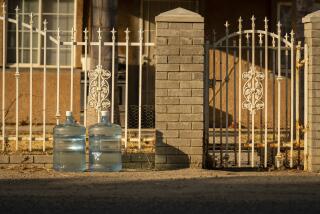Water Watch: Rationing Must Continue : A resource still critically low even after last month’s bountiful downpour
- Share via
Long ago, when drought loomed, California did something about it. At least it would plan to do something. A decade ago, for example, Southern California went about preparing for dramatic water shortages with a marvel of hydrologic engineering called the Peripheral Canal.
It would not have made up for all the water that Arizona was preparing to siphon from the Metropolitan Water District’s historic allocation, but it would have helped. The canal--which would have bypassed the Sacramento River delta to deliver cleaner water to pumps of both state and federal water projects for delivery to the south--has not been built. Because voters rejected the canal in a bitter and divisive referendum in 1982, even its name is taboo in some discussions of water. Southern Californians, for example, gingerly testified at a state hearing last week that the region still desperately needs the project without ever saying “Peripheral Canal.”
The canal also is a symbol of the end--at least for this century--of big construction projects that would add to the water supplies that could be moved from northern rivers to farms and dusty cities in the south.
What this bleak scrap of history means is that California water supplies, still critically low even after last month’s bountiful downpour, will stay that way for a long time.
Even if the construction started tomorrow, it would be years before the canal could raise water supplies, and the project still is formally “on the shelf” at the Department of Water Resources. No other projects to increase water supply are close to starting, either.
Because reservoirs hold only half of normal supplies, rationing will continue. The only new sources of drinking water in sight for growing urban populations are those from sales by farmers taking their land out of production. This makes a bill by Sen. Bill Bradley (D-N.J.) to let the federal government set up its own water banking system using some of the enormous flow of the Central Valley Project even more important.
Some new supplies for parks and other green space, industry and agriculture will come from expanding plants that treat waste water. But as the Los Angeles Department of Water and Power warned last week, not only will water remain scarce, it will cost more to pay for such regional efforts to expand supply. One estimate is that the current average price of $25 or $30 a month for water will increase to three or even four times that by the end of the decade.
This is how California must live until there is the capital to invest in--and the political will to plan for-- something better.
More to Read
Sign up for Essential California
The most important California stories and recommendations in your inbox every morning.
You may occasionally receive promotional content from the Los Angeles Times.












